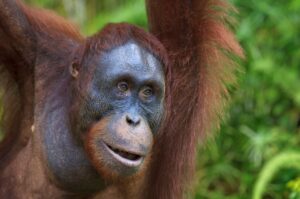What killed these bald eagles? In 1996, something very odd happened to bald eagles in Arkansas. The normally graceful birds were flying into cliffs and trees; on solid ground, they stumbled around as if dazed. Twenty-nine eagles turned up dead at a manmade reservoir. Scientists investigated and tested everything from radiation and heavy metals to cigarette smoke and pesticides but found nothing. Finally, after 25 years, the mystery has been solved. On the surface of the lake, a plant grew a cyanobacteria that released an unseen toxin. It gave the birds AVM, avian vacuolar myelinopathy, which forms empty spaces in the brain. Even then, the solution wasn’t that simple. The eagles didn’t get the disease directly from the plants. Coots on the same lake ate the plants, and the eagles ate the coots. The newly discovered toxin has been named aetokthonotoxin, “poison that kills the eagle”.
Garbage and melting ice create new habitats
The Great Pacific Garbage Patch is being colonized: The Great Pacific Garbage Patch is a 79,000-tonne mass of plastic waste floating between California and Hawaii. It covers 1.5 million square kilometres of ocean. It formed when sea currents trapped floating garbage. Multiple coastal species, including anemones and amphipods, are now making their homes on the plastic. “It’s creating opportunities for coastal species’ biogeography to greatly expand beyond what we previously thought possible,” said lead researcher Linsey Haram.

The Great Pacific Garbage Patch. Photo: TheOceanCleanUp
Melting glaciers may produce new salmon habitat: Pacific salmon need almost perfect conditions to reproduce, but their spawning streams are overheating, storms are ruining stream beds, and some are drying up. But there is hope for the species. By 2100, retreating glaciers in British Columbia and Alaska will open up six thousand kilometres of river habitat. A third of this will be suitable salmon nurseries. Some of the healthiest populations have formed along those coasts where new rivers have formed after the ice melted. Sadly, the new rivers may not last long. As the ice disappears entirely, the water will again become too warm for the salmon.
Cane toads are coming…
Toxic cane toads are invading Taiwan: Non-native, toxic toads are invading Taiwan. The cane toad is native to the Americas. When threatened, the poisonous species releases bufotoxin, a milky white toxin, from the glands behind its eyes. Investigators discovered over 200 toads in one area. As they have no natural predators in Taiwan, they can reproduce at a rapid pace. The invasion likely started months ago and went unnoticed. “Taiwanese farmers generally ignore toads and even look favorably [on] them, because they help rid the land of pests and are also a good luck symbol,” said expert Yang Yi-Ju. Cane toads were introduced to Australia decades ago and created many problems for local wildlife, as one highly entertaining documentary shows.

Cane toad. Photo: Shutterstock
Pig-nosed turtle fossil found in Australia: The pig-nosed turtle is a freshwater species found in northern Australia and southern New Guinea. Its fossil record dates to the Cretaceous period, about 100 million years ago. No such fossils had turned up in Australia, so scientists believed that they had reached the continent relatively recently. “The discovery of a five-million-year-old pig-nosed turtle fossil changes the picture entirely,” said Dr. Erich Fitzgerlad.
Where the honeybee began
The origins of the world’s most famous honeybee: Scientists have long debated where the western honeybee, the most common species, originated. A new study concludes that it began in western Asia. Scientists analyzed the genomes of 251 western honeybees from 18 subspecies across Europe, Asia, and Africa. The species originated seven million years ago and soon expanded westward. It first reached Africa, then Europe. Eventually, seven different honeybee lineages and 27 subspecies formed. They now live on every continent except Antarctica.

The western honeybee. Photo: Shutterstock
Light-colored feathers may help migrating birds: Half of the world’s bird species migrate. Many of them share a common feature: lighter-colored feathers. Researchers think that light coloration allows the birds to stay cool as they fly long distances. Migratory birds push their bodies to the limit, and this creates excess heat. The farther they migrate, the lighter their feathers.






